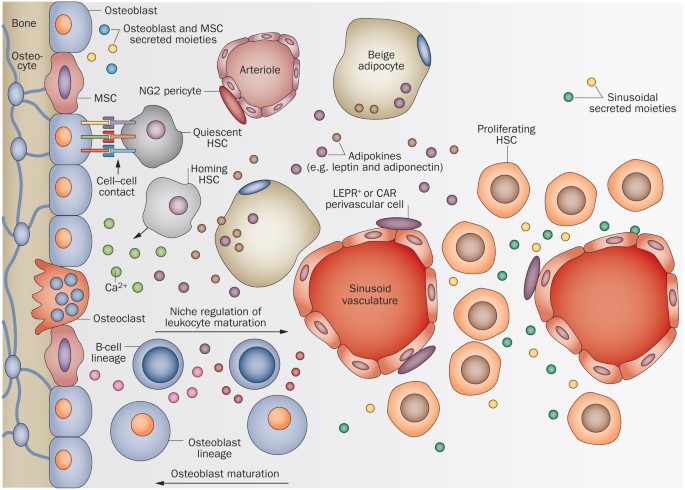DEFINITION
Bone marrow is the tissue found in the interior of bones. In humans, bone marrow in large bones produces all kind of new blood cells. On average, bone marrow constitutes 4% of the total body mass of humans; in adults weighing 65 kg, bone marrow accounts for approximately 2.6 kg.


Bone Marrow, Blood Cells, and the Lymphatic System
Cartoon
| Database | "URL": |
| "xxxx": | "URL": |
| "yyyyyy": | "URL": |
GROSS ANATOMY
The stroma of the bone marrow is all tissue not directly involved in the primary function of hematopoiesis. Yellow bone marrow makes up the majority of bone marrow stroma, in addition to smaller concentrations of stromal cells located in the red bone marrow.
Though not as active as parenchymal red marrow, stroma is indirectly involved in hematopoiesis, since it provides the hematopoietic microenvironment that facilitates hematopoiesis by the parenchymal cells. For instance, they generate colony stimulating factors, which have a significant effect on hematopoiesis.

- Vascularization
- Relationship with other organs
HISTOLOGY
Bone marrow is a niche devoted to protected cell proliferation. The rigid bone shell protects stem/proliferating cells against mechanical stress, there are no nerves and plenty of vessels.
Bone marrow cells are not forced to differentiate and can freely proliferate according to nutrients availabilty and hormonal signals.
The local environment:
- bone trabecules as a source of phosphate
- competition between different cell population (white blood cells (leukocytes), red blood cells (erythrocytes), and platelets (thrombocytes)
- blood flow and nutrients supply
will shape the bone marrow morphology in a dynamic way.
As feeding of human cells usually requires cell adhesion to an extracellular matrix all cells in bone marrow are endoved in a very soft stroma of mesenchimal origin,

Cells that constitute the bone marrow stroma are:
- fibroblasts (reticular connective tissue)
- macrophages
- adipocytes
- osteoblasts
- osteoclasts
- endothelial cells forming the sinusoids
Macrophages contribute especially to red blood cell production, as they deliver iron for hemoglobin production
Hematopoietic stem cells give rise to the three classes of blood cells that are found in the circulation: white blood cells (leukocytes), red blood cells (erythrocytes), and platelets (thrombocytes).
Mesenchymal stem cells
TISSUE SPECIFIC MOLECULES

During development, precursor cells become committed to skeletogenesis upon induction of the critical osteogenic transcription factor, cbfa1. The initial phenotype expressed by these cells is that of fully mature osteoblasts. Subsequently, when a threshold amount of bone has been formed, these cells form the primitive bone marrow stroma that serves as the bed upon which hematopoiesis occurs. At some point during the postnatal period, when hematopoiesis is sufficient, these same cells change phenotype yet again to become marrow adipocytes. Cells of these three phenotypes (osteoblastic, myelosupportive, and adipocytic) form a continuous network throughout the bone–bone marrow organ and maintain expression of cbfa1. These differentiated cells are able to shift from one phenotype to another, depending on the metabolic status of the organism. (Bone Marrow Stromal Cells, 2000)
- Enzymes
- Cell signaling
- Structural proteins
FUNCTIONS
biological functions (with links to other Flipper pages: Thyroid--> Thyroid Hormones)
EMBRIOLOGY
The history of tissue differentiation according to the sequential changes of the environment.
COMPETITION
Competion between different cell populations is regulated by signal peptides, namely:
- Erythropoietin
- TSLP
- Thrombopoietin
- extravascular fibrin clot
Estrogens upregulate cell proliferation in bone marrow
Estrogen increases coagulation factor V mRNA levels via both estrogen receptor-alpha and -beta in murine bone marrow/bone. 2004
Interestingly, 17beta-estradiol increased mRNA levels of coagulation factor V in the bone marrow/bone.
Non-malignant bone marrow necrosis: a report of two cases. 1998
- We present two cases of bone marrow necrosis not associated with malignancy, infection or sickle cell disease. The first case, a 28 year old woman with the antiphospholipid syndrome and a factor V Leiden abnormality, suffered an illness characterised by multiple organ thromboses, anemia and refractory thrombocytopenia. She had documented bone marrow necrosis of the posterior iliac spine and numerous hot spots on bone scanning suggestive of widespread marrow necrosis. This patient also suffered hepatic infarcts and a miscarriage and may represent an explanation for the previously described "catastrophic antiphospholipid syndrome". The second patient developed widespread bone pain over a three week period, underwent a cholecystectomy and suffered major post-operative complications including a delayed transfusion reaction and disseminated intravascular coagulation. Pancytopenia developed and bone marrow trephines from numerous foci revealed widespread bone marrow necrosis. The only predisposing factor to account for this presentation was that the patient had been sniffing glue for two months prior to the illness, as the foci of necrosis had healed on repeat marrow examination eight weeks later when the patient had abstained from glue sniffing. This case may represent a reversible, toxic cause of bone marrow necrosis.
Drug-induced hematologic syndromes. 2009
Glucocorticoids cause neutrophilia by inducing the release of neutrophils from the bone marrow.
Parvovirus B19
Serological study on parvovirus B19 infection in multitransfused thalassemia major patients and its transmission through donor units. 2011
Such a transmission of B19 infection leads to red cell aplasia, neutropenia, and thrombocytopenia.
Central macrophage and erythroblast island
binding+protein+central+macrophage+erythroblast
CD169

EMP = MAEA_HUMAN
Erythroblastic islands: niches for erythropoiesis. 2008

Microenvironmental factors involved in the establishment of erythropoiesis in bone marrow. 1994 Pubmed link